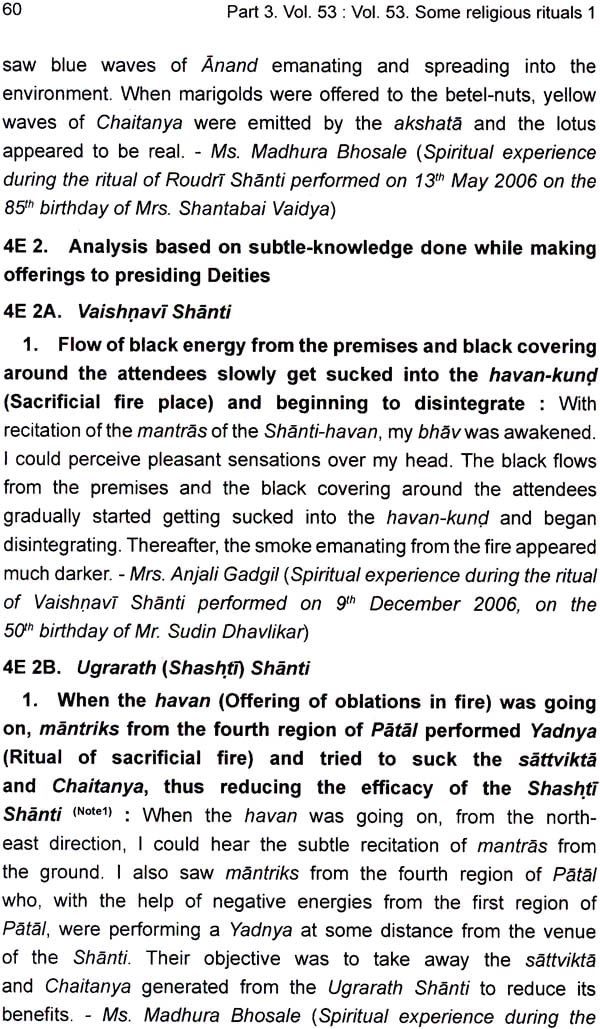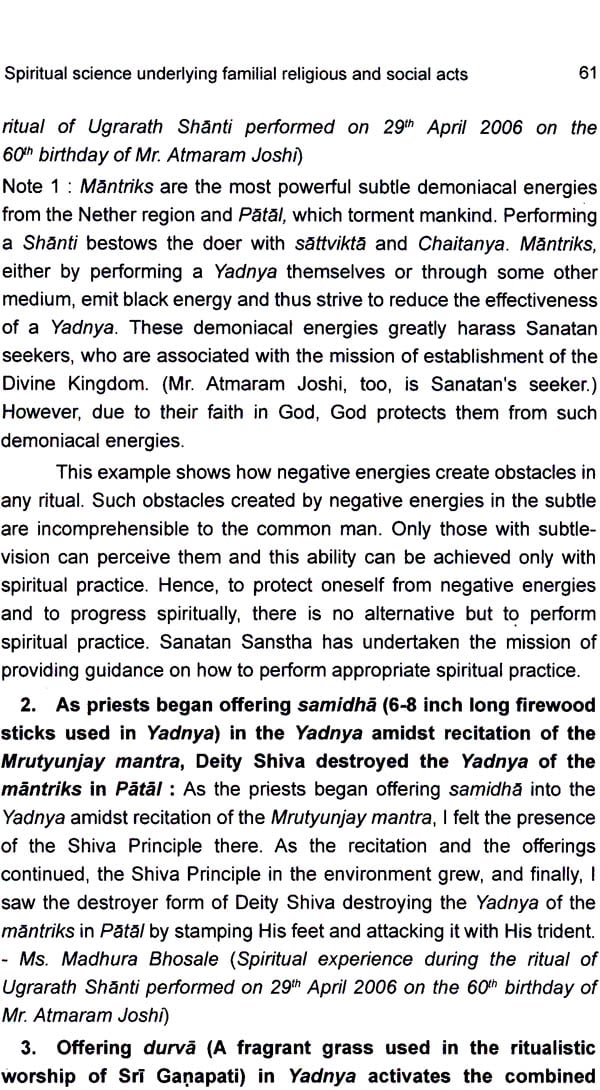
Spiritual Science Underlying Familial, Religious and Social Acts
Book Specification
| Item Code: | NAE575 |
| Author: | Various Authors |
| Publisher: | Sanatan Bharatiya Sanskriti Sanstha |
| Language: | English |
| Edition: | 2011 |
| ISBN: | 9788189970680 |
| Pages: | 100 (13 B/W Illustrations) |
| Cover: | Paperback |
| Other Details | 8.5 inch x 5.5 inch |
| Weight | 50 gm |
Book Description
The appropriate method of performing Dharmik acts and their underlying spiritual science is provided in the series of Holy texts on “What do Dharmashastras say and why?” If Dharmilk acts are performed appropriately from the spiritual perspective, they bestow more Chaitanya. When an action is performed after learning its underlying science, it generates spiritual emotion towards God and the worshipper becomes a seeker in a shorter time, that is, he starts making consistent efforts for God-realization.
Dr. Jayant Athavale started writing Holy text with the blessings of His Guru H.H. Bhaktaraj Maharaj. There Holy text imparts knowledge on Spirituality in scientific terminology and as per the present times. Due to God’s grace and Sankalp-shakti of dr. Athavale, some seekers of Sanatan are receiving Divine knowledge from the subtle- this is the unique feature of these Holy-texts.
Dr. Ashville’s guidance and research on God-realization through various art forms and subjects such as mission of demoniacal energies and guidance for protecting humanity from them is taking place incessantly.
There is a proverb in Sankrut which means, Happiness in the true sense (Anand) is possible only by being religious that is, by following Dharma; hence always endeavor to follow it. Though the medium of various religious naturals sanskars (Subconscious impressions), Festivals, Vowed observance etc., Hindu Dharma has shown to be religions while continuing to lead a materialistic life. Hindu Dharma has conveyed its message of being religions through not only daily ritualistic worship or acts related to worship during Holy and Religious festivals, Vowed religious observance etc. but also though various familial and social rituals.
Only when a designated act is supportant by rituals as prescribed by Hindu Dharma, mining the course defined by rituals that have a spiritual basis is adhered to, that we obtain the grace of Deities. This also helps in protecting us from negative energies. Along with the individual, such acts bestow benefit upon the society too, and hence, it becomes samashti sadhana Spiritual practice for the spread of Spirituality in the society. This Holy text elaborates upon the objectives, the correct method of performing a ritual and underlying spiritual science of familial religious ritual such as birthday celebration, aukshan, gifting, performance of the ritual of Shanti (Peasc) as per one’s age and social rituals such as inauguration, lighting of an inaugural lamp, felicitation, condolence meetings etc. When a ritual is performed with complete faith after understanding the underlying spiritual science, benefit derived is greater. Importance of reciting Sanskrut shlokas (Holy verses) and information on which shlokas to recite during spiritual discourses, book exhibitions, condolence meetings, relies etc. is also provided in this Holy text.
In today’s times, Hindus are more influenced by western culture. The combined effect of forgetting our own Dharma as well as our culture, coupled with the fascination for western culture, is the reason for large-scale influence of western culture on our religions rituals. This is quite clear from a number of practices such as celebration a birthday by cutting a cake and blowing candles instead of performing amusing aukshan; infuriating a premise by cutting a ribbon instead of purifying the place by breaking a coconut; lighting the ceremonious lamp with a candle and not with a wick of an oil lamp etc. That these acts do not bestow chaitanya (Divine consciousness) and are spiritually detrimental has been explained in the Holy text along with the underlying spiritual science. We pray at the holy feet of Sri Guru that let everyone progress spiritually, both at the vyashti (Individual) and samashti (For the sake of the society) level by performing the rituals according to the underlying spiritual science as mentioned in the Holy text and let pride Dharma and culture be awakened in Hindus.-Compiler.
| Preface | 8 | |
| Commentary by ‘A Scholar’ on the Divine knowledge received about this Holy text | 10 | |
| Some terms used in connection with the ‘Subtle dimension’ and their meanings | 13 | |
| Introduction to the recipients of Divine Knowledge and the Compilers | 15 | |
| Chapter 1: Spiritual science underlying familial religious rituals | ||
| 1 | Birthday | 16 |
| 1A. | Spiritual meaning | 16 |
| 1B | History and importance of birthday celebrations | 17 |
| 1C | Importance of celebrating the birthday as per the tithl | 18 |
| 1D | Method of celebrating a birthday | 24 |
| 1E | Everybody Can Laugh Spiritual science underlying the ritual of birthday celebration | 26 |
| 1F | Spiritual experience during birthday celebrations | 29 |
| 1G | Acts prohibited on a birthday and the underlying spiritual science | 30 |
| 1H | Analysis based on subtle-Knowledge of a birthday celebrated according to the western culture | 33 |
| 1I | A Saint’s birthday | 37 |
| 1J | Birthday celebration of children people of the same age, the elderly and Saints | 37 |
| 2 | Aukshan | 39 |
| 2A | Spiritual meaning of aukshan | 39 |
| 2B | Importance of aukshan | 39 |
| 2C | On whom is aukshan performed | 39 |
| 2D | Where is aukshan performed | 39 |
| 2E | Objects required for aukshan and their arrangement in the ritualistic platter | 40 |
| 2F | Method of aukshan | 42 |
| 2G | Spiritual science underlying the actions aukshan | 43 |
| 2H | Reasons underlying the various methods of aukshan and the effect on a jiva | 52 |
| 2I | Actual worship, aukshan, mental worship, remembrance and mental recitation | 53 |
| 2J | Spiritual experience during aukshan | 54 |
| 3 | Presenting a gift | 55 |
| 3A | Meaning of the words gift | 55 |
| 3B | What is an appropriate gift | 55 |
| 3C | What is the best gift and who can offer it | 55 |
| 3D | What should be the bhav while presenting gifts | 55 |
| 3E | Why are haldi and Kumkum applied to the gift before presenting it | 55 |
| 4 | Ritual of Shanti | 56 |
| 4A | Objective | 56 |
| 4B | Selected date for Shanti | 56 |
| 4C | Various types of Shanti, the presiding Deities of Shanti, and offerings | 56 |
| 4D | Importance of the Sahastra-chandra-darshan Shanti | 57 |
| 4E | Analysis based on subtle-Knowledge of some ritualsperformed in Shanti | 59 |
| 5 | Satyanarayan-puja | 65 |
| 5A | Importance of performing Satyanrayan-puja before a function | 65 |
| 5B | Satyanarayan-puja- Analysis (based on subtle knowledge) done by Ms. Madhura Bhosale | 66 |
| Chapter 2: | Spiritual scirnce underlying social rituuals | |
| 1 | Inauguration | 69 |
| 1A | Definition | 69 |
| 1B | Importaaance | 69 |
| 1C | Rituals in inauguration/td> | 69 |
| 1D | Why is the western tradition of inaugurating by cutting a ribbon inappropriate | 71 |
| 2 | Lighting a ceremonious lamp | 73 |
| * | Importance of lighting a ceremonious lamp | 74 |
| * | Spiritual science underiying lighting a ceremonious lamp and breaking a coconut when inaugurating a programme on the stage | 75 |
| 3 | Felicitation | 81 |
| * | Who should do the felicitation | 82 |
| * | What should be avoided during felicitation | 85 |
| * | Comparison of felicitation of a deserving jiva, a Saint and an ldol of a Deity | 86 |
| 4 | Granth-prakashan (Release of a Holy text or book using spiritual principles) | 86 |
| * | Why ahould we not release a book by first tying it with a ribbon and then untying it | 88 |
| * | Analysis based on subtly-knowlege done by Mrs. Anjali Gadgil at the release of the Holy text 'Spiritual Practice' published by Sanatan Sanstha | 88 |
| 5 | Why is it necessary to recite Sanskrut shlokas at functions on various topiccs, and which one to recite when | 89 |
| 6 | The composition of a stage programme of one two sessions | 92 |
| 7 | Condolence meeting | 93 |







